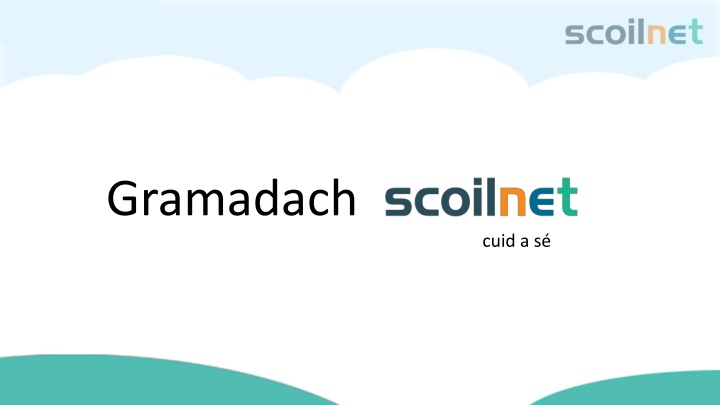Future Tense in Irish Grammar: Practice and Examples
Learn how to form and use the future tense in Irish grammar with 1-syllable broad verbs. Understand the rules for asking questions, making negative statements, and practice conjugating verbs like "ceap" (to think), "glan" (to clean), and "dún" (to close). Enhance your understanding of verb endings and sentence structure for talking about future actions.
Download Presentation

Please find below an Image/Link to download the presentation.
The content on the website is provided AS IS for your information and personal use only. It may not be sold, licensed, or shared on other websites without obtaining consent from the author.If you encounter any issues during the download, it is possible that the publisher has removed the file from their server.
You are allowed to download the files provided on this website for personal or commercial use, subject to the condition that they are used lawfully. All files are the property of their respective owners.
The content on the website is provided AS IS for your information and personal use only. It may not be sold, licensed, or shared on other websites without obtaining consent from the author.
E N D
Presentation Transcript
Gramadach cuid a s
An Aimsir Fhistineach Amrach (Future Tense - Tomorrow) 1 syllable broad verbs 1 syllable broad verbs In the future tense, there is no need to add a h like we did in the past tense. Instead, we add an ending to the root of the verb. There are four different endings in the present tense. For 1 syllable broad verbs in the future tense, we add faidh to the end of the root verb. For example Glan becomes Glanfaidh Will clean The other difficult part is when we want to say we do something in the present tense. With broad verbs in the future tense, we add faimid onto the end of the stem of the verb. For example Glan becomes Glanfaimid We will clean
An Aimsir Fhistineach Amrach (Future Tense - Tomorrow) 1 1 syllable broad verbs syllable broad verbs Ceisteach agus Di ltach (Questions and Negative) To ask a question in the future tense, we put An before and faidh after the verb e.g. An glanfaidh t ? - Will you clean? To say that you didn t do something, we put N before the word, a h after the first letter and a faidh at the end e.g. N ghlanfaidh m - I will not clean
An Aimsir Fhistineach Amrach (Future Tense - Tomorrow) 1 syllable broad 1 syllable broad verbs verbs Cleachtadh - Practice ceap to think glan to clean d n to close ceapfaidh I will think glanfaidh m I will clean d nfaidh m I will close ceapfaidh t You will think glanfaidh t You will clean d nfaidh t You will close ceapfaidh s He will think glanfaidh s He will clean d nfaidh s He will close ceapfaidh s She will think glanfaidh s She will clean d nfaidh s She will close ceapfaimid We will think glanfaimid We will clean d nfaimid We will close ceapfaidh sibh You(pl) will think glanfaidh sibh You(pl) will clean d nfaidh sibh You (pl) will close ceapfaidh siad They will think glanfaidh siad They will clean d nfaidh siad They will close An gceapfaidh t ? Will you think? An nglanfaidh t ? Will you clean? An nd nfaidh t ? Will you close? N cheapfaidh m I will not think N ghlanfaidh s He will not clean N dh nfaidh m I will not close
An Aimsir Fhistineach Amrach (Future Tense - Tomorrow) 1 1 syllable broad verbs syllable broad verbs Quick Recap: 1. There is no need to add a h like we did in the past tense. 2. To say something in the future tense, we add faidh onto the root of the verb e.g. Glanfaidh m . 3. We add faimid to the root of the verb to say we will do something e.g. Glanfaimid. 4. To ask a question, we use An and an ur e.g. An nglanfaidh t ? 5. To say the negative, we use N and add a h after the first letter e.g. N ghlanfaidh m .

